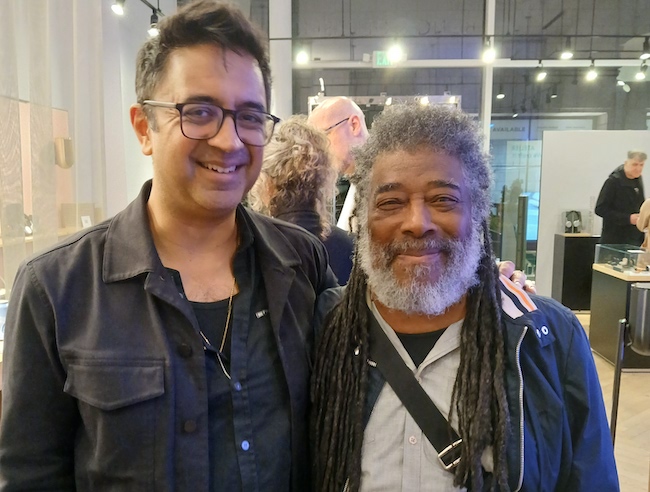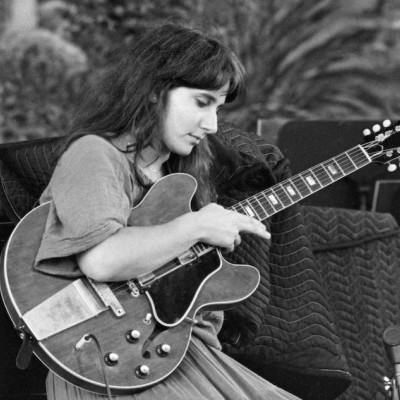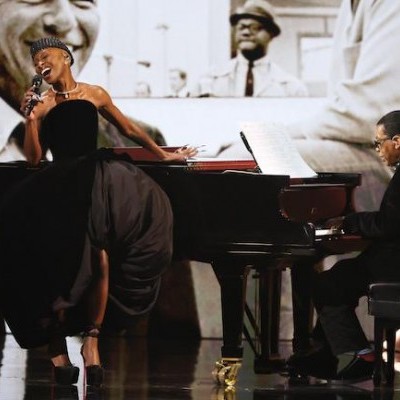Feb 3, 2025 10:49 PM
The Essence of Emily
In the April 1982 issue of People magazine, under the heading “Lookout: A Guide To The Up and Coming,” jazz…

“It’s an honor and a blessing to be in this universe with Mr. Smith,” said Vijay Iyer, left, of Wadada Leo Smith, right, at the March 20 release party for their latest duo recording, Defiant Life (ECM).
(Photo: Phillip Lutz)On March 20, the night before the release of Defiant Life, the new Vijay Iyer-Wadada Leo Smith duo album from ECM, the label was throwing what their invitation termed a “private listening party” at Bang & Olufsen, the high-end electronics store on Madison Avenue in New York.
Fully nine years had elapsed since the duo’s first release, A Cosmic Rhythm With Each Stroke. That album, also on ECM, was something of a revelation to those who had not experienced the pianist and trumpeter performing as a twosome, which they had been doing for about a decade. So the new record was a cause to celebrate.
A couple dozen friends, associates and a smattering of other guests agreed. Wandering in from a cusp-of-spring icy rain, the larger share of the celebrants gathered in the store’s ample front room, where they seemed content to enjoy the well-heated space, the light refreshments and some modest revelry.
But the real action was in the small back room. There, the new album was playing on a loop. And that was where Iyer, Smith and a coterie had settled in for much of the evening, drinking in the otherworldly vibrations that only a recording by a deeply harmonious pairing — and a $150,000 sound system — could set in motion.
As the music unfolded — six tracks challenging listeners to reconcile shimmering beauty with shattering portent — the back-room crowd seemed mesmerized, and no one more than Smith. Perched atop a stool at one end of the room, he rocked gently back and forth, eyes closed and a smile threatening to break out across his face.
Iyer, meanwhile, stood at the other end of the room, wearing the inscrutable expression that the uninitiated have, over the years, mistaken as the triumph of intellect over emotion. After an ECM representative herded those in the back room to the front room, Iyer made an impassioned — if calmy considered and coolly delivered — statement to the full complement of revelers.
“It’s an honor and a blessing to be in this universe with Mr. Smith,” he said.
Such deference is typical of the way Iyer relates personally to Smith, who, at 82 years old, is nearly three decades his senior. But when the music-making begins, the deference yields to mutual respect. United by their values — what Iyer in his liner notes calls the “shared aesthetic of necessity” — Smith and Iyer are obliged to meet on an equal footing in pursuit of “what must be done and why.”
Individually, Iyer and Smith have a history of addressing the brutalities of American society. So it seems inevitable that what must be done will enter the political realm, though through a spiritual back door. It is a process that, as the party crowd began to thin, Iyer, wine glass in hand — and “Kite (for Refaat Alareer),” his transcendent ode to the late Palestinian writer, playing in the background — expanded on.
Music, he said, can connect with the spirits of those who lost their lives defying the agents of social injustice. That tenet has been central to his duo with Smith since they began their journey 20 years ago, a development that grew out of an interruption in the flow of a performance with Smith’s Golden Quartet, of which Iyer was a member. As Iyer explained, that moment set the pattern for the duo’s operation to this day.
“The music reaches a point of breakdown or crisis and we start moving into that empty space, step by step,” he said. “There’s nothing in front of us except what we put in front of us. And this is exactly how this music was born — out of that experience of necessity and recovery and also in this constructive kind of gesture. And somehow we found ourselves doing that together, and this duo came from that and continues in this fashion.”
Ultimately, the duo’s power derives from an accretion of those gestures, which Iyer likened to the stages of personal discovery through which a kind of resurrection of the departed can be achieved: “These little moments where we’re memorializing particular figures are also part of that spiritual process: communing with those who are no longer here, contemplating how they are actually still here. It’s this ongoing livingness they acquire in this process.”
On “Floating River Requiem (For Patrice Lumumba),” Smith’s written contribution to Defiant Life, Iyer’s grand piano and Smith’s open trumpet slowly but purposefully construct a colloquy that evokes the defiantly life-affirming last moments of the Congolese leader as he faced execution at the hands of his colonizers in the early 1960s.
“He is seeing across that threshold,” Iyer said, “seeing his legacy or immortal self in that moment. So when we talk about spirituality, we’re not bypassing the political. We’re actually in the same place.”
As Iyer spoke, “Kite,” now a background presence, was, as if on cue, conjuring such a moment — one in which Smith’s trumpet (dwelling on elegiac long tones) and Iyer’s Rhodes (inhabiting the ethereal reaches of the upper keyboard) float so lightly and with such intent that, as they fade into evanescence, listeners with even a modicum of faith might imagine them crossing to another plane.
The piece was written after the December 2023 death of Alareer, who had defied Israeli orders to vacate his Gazan home, and recorded by Iyer and Smith in Lugano, Switzerland, in July 2024. By that time, Iyer said, “we were already arriving at the understanding” of the “system we live under in terms of the sheer hypocrisy about human rights.”
Whatever one’s view of the system, the clarifying nature of the art is difficult to deny. And that, Iyer said, owes in no small part to Smith’s perspective as a son of segregated Mississippi who learned to take the long view on abuses.
“It’s horrific,” Iyer, a son of the South Asian diaspora, said of the current situation, “but it’s not new.”
Smith, asked his view of the project eight months after recording the album, was remarkably sanguine. The smile that had threatened to break out as he listened to the music did so.
“It lets me know that Vijay and I have a much closer relationship than anyone can imagine,” he said, “and that the music we create is more than spontaneous. It’s made in a way as if we’re building a creation. And that creation itself informs us that we are indeed part of this planet.” DB

“She said, ‘A lot of people are going to try and stop you,’” Sheryl Bailey recalls of the advice she received from jazz guitarist Emily Remler (1957–’90). “‘They’re going to say you slept with somebody, you’re a dyke, you’re this and that and the other. Don’t listen to them, and just keep playing.’”
Feb 3, 2025 10:49 PM
In the April 1982 issue of People magazine, under the heading “Lookout: A Guide To The Up and Coming,” jazz…

As Ted Nash, left, departs the alto saxophone chair for LCJO, Alexa Tarantino steps in as the band’s first female full-time member.
Mar 4, 2025 1:29 PM
If only because openings for JLCO’s 15 permanent positions appear about as frequently as sub-freezing days on the…

Larry Appelbaum with Wayne Shorter in 2012.
Feb 25, 2025 10:49 AM
Larry Appelbaum, a distinguished audio engineer, jazz journalist, historian and broadcaster, died Feb. 21, 2025, in…

“This is one of the great gifts that Coltrane gave us — he gave us a key to the cosmos in this recording,” says John McLaughlin.
Mar 18, 2025 3:00 PM
In his original liner notes to A Love Supreme, John Coltrane wrote: “Yes, it is true — ‘seek and ye shall…

Cynthia Erivo and Herbie Hancock perform “Fly Me To The Moon” during a Grammy Awards tribute to Quincy Jones on Feb. 2.
Feb 3, 2025 10:21 PM
The jazz and blues community may not have been center stage for the majority of the 67th annual Grammy Award…